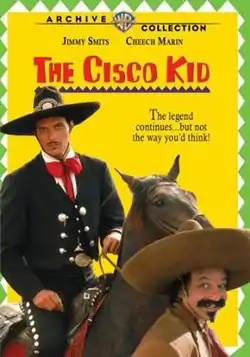The Cisco Kid (1994 film)
The Cisco Kid is an American 1994 TV movie, which updated the successful 1950s comedy western television series, and 1940s movie serial.[1] The film was written by Michael Kane and directed by Luis Valdez. Jimmy Smits played the Cisco Kid, the role previously played by Duncan Renaldo, Gilbert Roland, and Cesar Romero. Cheech Marin played his sidekick Pancho. Bruce Payne and Ron Perlman played French villains.[2] The film aired on the TNT Network.[3]
| The Cisco Kid | |
|---|---|
 | |
| Genre | Comedy Western |
| Based on | O. Henry (character) |
| Written by | Michael Kane Luis Valdez |
| Directed by | Luis Valdez |
| Starring | Jimmy Smits Cheech Marin |
| Music by | Joseph Julián González |
| Country of origin | United States |
| Original language | English |
| Production | |
| Executive producer | Moctesuma Esparza |
| Producers | Gary M. Goodman Robert Katz Barry Rosen Ramiro Jaloma (associate producer) |
| Production locations | Sinaloa, Mexico Sombrerete, Zacatecas Zacatecas, Zacatecas Guadalupe, Zacatecas Pachuca, Hidalgo San Pedro Tlochataco, Hidalgo Santa Maria Regla, Hidalgo Sierra de Organos, Sombrerete, Zacatecas |
| Cinematography | Guillermo Navarro |
| Editor | Zach Staenberg |
| Running time | 91 minutes |
| Production company | Turner Pictures |
| Distributor | Warner Bros. |
| Release | |
| Picture format | Color |
| Audio format | Ultra Stereo |
| Original release | February 6, 1994 |
Plot
The Cisco Kid and Poncho are about to be executed by the French, who have taken over part of Mexico, when an attack on the prison by rebels allows them both to escape. Still chained together, they steal a burro and ride to a nearby village where they come upon a tax collector and several soldiers in the process of taking money from the villagers. The pair manage to overcome the soldiers, and using their guns, free themselves from the chains and rob the tax collector.
Pancho takes Cisco back to his village, where the pair inspire Mexican peasants to oust settlers from the Second French Empire. The action continues with gun battles, kidnapping, swordplay, humor and suspense.[4]
Production
The film was directed by Luis Valdez.[5] Filming took place in Sierra de Órganos National Park in the town of Sombrerete, Mexico
Review
Just before its initial airing, Todd Everett of Variety praised the casting of Jimmy Smits in the role of The Cisco Kid as "ideal", and wrote that Cheech Marin as Pancho had "never been more appealing". He predicted that the film would have broad appeal.[6] Kim Newman of Empire stated that the film was 'a likeable cable revival for the old 1950s series Western character' and noted that it depicted Mexicans in a less stereotypical fashion than the original television series.[7] Nonetheless, Newman stated that it 'continues to depict the French (Bruce Payne, Ron Perlman) as effete sadists and the gringos (Tim Thomerson) as grungy swine'.[7] Mick Martin and Marsha Porter stated that it was an 'enjoyable, lighthearted Western...spiced with humor and enthusiastic performances by Jimmy Smits and Richard 'Cheech' Marin'.[8] Terry Rowan described the film as a 'tongue-in-cheek comedy western filled with fast gunplay, narrow escapes, wild rides, battling armies and yes, some romance'.[4]
Cast
- Jimmy Smits as Cisco Kid
- Cheech Marin as Pancho
- Sadie Frost as Dominique
- Bruce Payne as General Martin Dupre
- Ron Perlman as Lt. Col. Delacroix
- Tony Amendola as Washam
- Tim Thomerson as Lundquist
- Pedro Armendáriz, Jr. as General Montano (as Pedro Armendariz)
- Phil Esparza as Kessler
- Clayton Landey as Van Boose
- Charles McCaughan as Haynie
- Tony Pandolfo as Alain Vitton
- Roger Cudney as Alcott
References
- "TV REVIEWS : 'Cisco Kid' Is Back With Jimmy Smits". Los Angeles Times, February 05, 1994 | RAY LOYND
- Hall, Steve (3 February 1994). "Cisco Kid returns in TNT film". The Indianapolis Star. Retrieved 7 December 2011.
- Darling, Juanita (13 January 1994). "'The Cisco Kid' Walks Between Two Worlds". Los Angeles Times.
- Rowan, Terry (2013). The American Western A Complete Film Guide. Lulu.com. ISBN 9781300418580. Retrieved 31 October 2020.
- Caulfield, Carlota; Davis, Darién J. (2007). A Companion to US Latino Literatures. Boydell & Brewer Ltd. pp. 215–. ISBN 978-1-85566-139-4.
- Everett, Todd. "Review: 'The Cisco Kid'". Variety. Retrieved 2017-08-25.
- Newman, Kim (1 January 2000). "The Cisco Kid Review". Empire. Retrieved 31 October 2020.
- Martin, Mick; Porter, Marsha (1994). Video Movie Guide 1995. Ballatine. ISBN 9780345391964. Retrieved 31 October 2020.